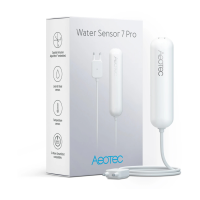Supported Command Classes
• Configuration Command Class, Version 4 (highest granted security level)
• Multilevel Sensor Command Class, Version 11 (highest granted security level)
• Multi Channel Association Command Class, Version 3 (highest granted security level)
• Association Group Information Command Class, Version 3 (highest granted security level)
• Device Reset Locally Command Class, Version 1 (highest granted security level)
• Z-Wave Plus Info Command Class, Version 2 (non-Secure)
• Notification Command Class, Version 8 (highest granted security level)
• Manufacturer Specific Command Class, Version 2 (highest granted security level)
• Powerlevel Command Class, Version 1 (highest granted security level)
• Firmware Update Meta Data Command Class, Version 5 (highest granted security level)
• Battery Command Class, Version 1 (highest granted security level)
• Wake Up Command Class, Version 2 (highest granted security level)
• Indicator Command Class, Version 3 (highest granted security level)
• Association Command Class, Version 2 (highest granted security level)
• Version Command Class, Version 3 (highest granted security level)
• Security 2 Command Class, Version 1 (highest granted security level)
• Supervision Command Class, Version 1 (non-Secure)
• Transport Service Command Class, Version 2 (non-Secure)
Explanation of Z-Wave specific terms
• Controller — is a Z-Wave device with capabilities to manage the network. Controllers are typically
Gateways,Remote Controls or battery operated wall controllers.
• Slave — is a Z-Wave device without capabilities to manage the network. Slaves can be sensors,
actuators and even remote controls.
• Primary Controller — is the central organizer of the network. It must be a controller. There can be only
one primary controller in a Z-Wave network.
• Inclusion — is the process of adding new Z-Wave devices into a network.

